Prehistoric Peak Distrct Roman and Saxon Barrows
Prehistoric Peak Distrct Roman and Saxon Barrows is in Prehistoric Peak District, Saxon Monuments.
Europe, British Isles, North-Central England, Derbyshire Dales, Monyash, Benty Grange Barrow [Map]
Benty Grange. May 3rd. - It was our good fortune to open a barrow which afforded a more instructive collection of relics than has ever been discovered in the county, and which are not surpassed in interest by any remains hitherto recovered from any Anglo-Saxon burying place in the kingdom.
The barrow [Benty Grange Barrow [Map]], which is on a farm called Benty Grange, a high and bleak situation to the right of the road from Ashbourn to Buxton, near the eighth milestone from the latter place, is of inconsiderable elevation, perhaps not more than two feet at the highest point, but is spread over a pretty large area, and is surrounded by a small fosse or trench. About the centre and upon the natural soil, had been laid the only body the barrow ever contained, of which not a vestige besides the hair could be distinguished. Near the place which, from the presence of hair, was judged to have been the situation of the head, was a curious assemblage of ornaments, which, from the peculiarly indurated nature of the earth, it was impossible to remove with any degree of success. The most remarkable are the silver edging and ornaments of a leathern cup, about three inches diameter at the mouth, which was decorated by four wheel-shaped ornaments and two crosses of thin silver, affixed by pins of the same metal, clenched inside.
The other articles found in the same situation consist of personal ornaments, the chief of which are two circular enamels upon copper 1¾ diameter, in narrow silver frames, and a third, which was so far decomposed as to be irrecoverable; they are enamelled with a yellow interlaced dracontine pattern, intermingled with that peculiar scroll design, visible on the same class of ornaments figured in Vestiges p. 25, and used in several manuscripts of the Vllth Century, for the purpose of decorating the initial letters. The principle of this design consists of three spiral lines springing from a common centre, and each involution forming an additional centre for an extension of the pattern, which may be adapted to fill spaces of almost any form. Mr. Westwood has shown in a most able paper in the 40th No. of the Journal of the Archæological Institute, that this style of ornamentation is peculiar to the Anglo-Saxon and Irish Artists of the period before stated. The pattern was first cut in the metal, threads of it being left to show the design, by which means cells were formed, in which the enamel was placed before fusion, the whole being then polished became what is known as Champ-levé enamel. There was also with these enamels a knot of very fine wire, and a quantity of thin bone variously ornamented with lozenges &c, which was mostly too much decayed to bear removal; it appeared to have been attached to some garment of silk, as the glossy fibre of such a fabric was very perceptible when they were first uncovered, though it shortly vanished when exposed to the air. Proceeding westward from the head for about six feet, we arrived at a large mass of oxidyzed iron, which, being removed with the utmost care, and having been since repaired, were unavoidably broken, now presents a mass of chainwork, and the frame of a helmet. The latter consists of a skeleton formed of iron bands, radiating from the crown of the head, and riveted to a circle of the same metal which encompassed the brow: from the impression on the metal it is evident that the outside was covered with plates of horn disposed diagonally so as to produce a herring-bone pattern, the ends of these plates were secured beneath with strips of horn corresponding with the iron framework, and attached to it by ornamental rivets of silver at intervals of about an inch and a half from each other; on the bottom of the front rib, which projects so as to form a nasal, is a small silver cross slightly ornamented round the edges by a beaded moulding; and on the crown of the helmet is an elliptical bronze plate supporting the figure of an animal carved in iron, with bronze eyes, now much corroded, but perfectly distinct as there presentation of a hog. There are too, many fragments, some more or less ornamented with silver, which have been riveted to some part of the helmet in a manner not to be explained or even understood, there are also some small buckles of iron which probably served to fasten it upon the head. Amongst the chainwork is a very curious six-pronged instrument of iron, in shape much like an ordinary hay-fork, with the difference of the tang, which in the latter is driven into the shaft, being in this instrument flattened and doubled over so as to form a small loop apparently convenient for suspension; whether it belonged to the helmet or the corselet, next to be described, is uncertain. The iron chainwork already named, consists of a large number of links of two kinds, attached to each other by small rings half an inch diameter; one kind are flat and lozenge, shaped, about an inch and a half long; the others are all of one kind but of different lengths, varying from 4 to 10 inches. They are simply lengths of square rod iron with perforated ends, through which pass the rings connecting them with the diamond shaped links; they all show the impression of cloth over a considerable part of the surface, and it is therefore no improbable conjecture that they would originally constitute a kind of quilted cuirass, by being sewn up within, or upon a doublet of strong clotL The peculiarly indurated and corrosive nature of the soil in this barrow is a point of some interest, and it will not be out of place to state that such has generally been the case in tumuli in Derbyshire, where the more important Saxon burials have taken place, whilst the more ancient Celtic interments are generally found in good condition owing to there having been no special preparation of the earth, which in these cases has undergone a mixing or tempering with some corrosive liquid; the result of which is the presence of thin ochrey veins in the earth, and the decomposition of nearly the whole of the human remains. The following extract from Professor Worsaae's Antiquities of Denmark, illustrates the helmet which is the only example of the kind hitherto discovered either in this country or on the Continent.
"The helmets (of the ancient Scandinavians) which were furnished with crests, usually in the form of animals, were probably in most cases only the skins of the heads of animals, drawn over a framework of wood or leather, as the coat of mail was usually of strong quilted linen or thick woven cloth."
To this the translator of the English edition appends the important information, that "the animal generally represented was the boar; and it is to this custom that reference is made in Beowulf where the poet speaks of the boar of gold, the boar hard as iron."
"Swyn eal - gylden, Eofer Iren - heard."
Nor are allusions to this custom of wearing the figure of a boar - not in honour of the animal, but of Freya, to whom it was sacred - confined to Beowulf, they are to be found in the Edda and in the Sagas; while Tacitus in his work, De Moribus Germanorum, distinctly refers to the same usage and its religious intention, as propitiating the protection of their Goddess in battle. As a further illustration, not only of the helmet, but also of the chainwork, the following extracts from Beowulf are transcribed from Mr. 0. R. Smith's Collectanea Antiqua, vol. II, p. 240.
eofer-líc sciónon ofer-hleor beran; ge-hroden golde fah and fyr-heard, ferh-wearde heóld. Be-fongen freá-wrásnum, swa híne fyrn-dagum worhte waspna smith, wundrum teóde, be-sette swín-lícum, that hine sythan nó brond né beado-mecas bitan ne meahton: Æt thæm áde wæs eth-ge-syne swát-fah-syrce swyn eal-gylden, eofer íren heard; Hé thá in-beran eafor heáfod-segn, heago-steápne helm, [se] are-byman, guth-sweord geáto-líc:
They seemed a boar's form to bear over their cheeks; twisted with gold, variegated and hardened in the fire, this kept the guard of life: Surrounded with lordly chains, even as in days of yore the weapon smith had wrought it, had wondrously furnished it, [swine,] had set it round with the shapes of that never afterwards brand or war-knife might have power to bite it; At the pile was easy to be seen the mail shirt covered with gore, the hog of gold, the boar hard as iron: Then commanded he to bring in the boar, an ornament to the head, the helmet lofty in wars, the grey mail coat, the ready battle sword.
Note. The original and a reconstructed helmter are on display at the Weston Park Museum, Sheffield.
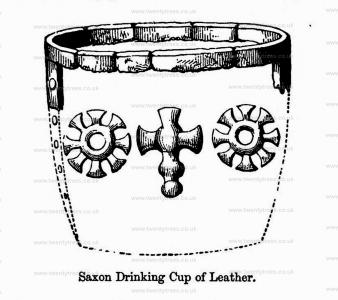
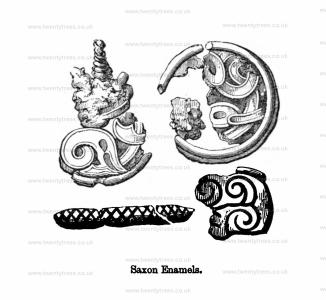
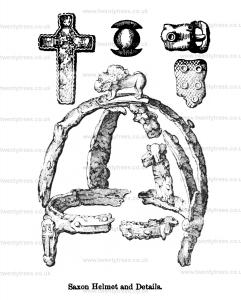
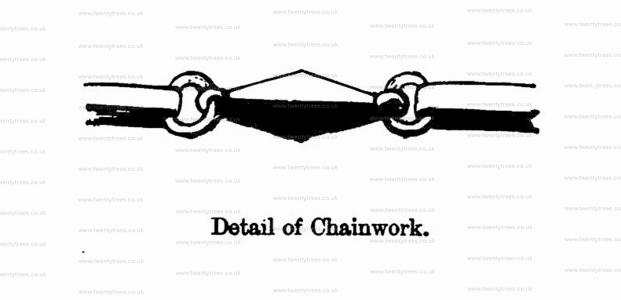
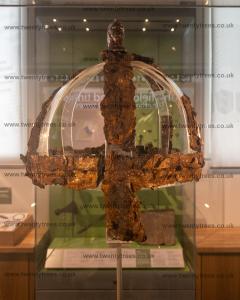
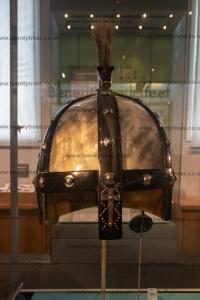
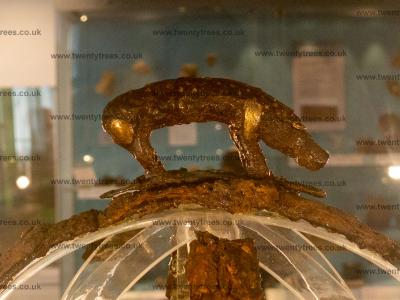
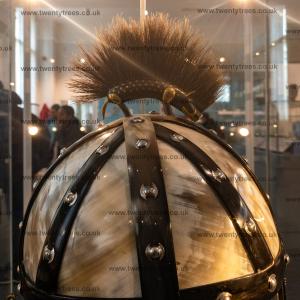
Europe, British Isles, North-Central England, Derbyshire Dales, Monyash, Burton Moor Barrow [Map]
Over Haddon. On the 30th of April a barrow [Map] [Burton Moor Barrow [Map]] near Over Haddon, in land called Grindlow, was examined as completely as the meeting of three walls on its summit would allow. It had been much mutilated; but fortunately the primitive interments lay too deep to receive injury from the labours of those in search of stone, by whom an important interment of secondary date had been destroyed. The original deposit had been made on the rock a little below the natural surface, and about 5 feet from the top of the mound; it comprised three skeletons, laid in the usual contracted position, two of which were females; with them were one or two rude instruments of flint, and a fine collection of jet ornaments, 73 In number, which form a very handsome necklace. Of these 26 are cylindrical beads, 39 are conical studs, pierced at the back by two holes meeting at an angle in the centre; and the remaining 8 are flat dividing plates, ornamented in the front with a punctured chevron pattern, superficially drilled in the jet; 7 of them are laterally perforated with three holes, to admit of their being connected by a triple row of the cylindrical beads, whilst the 8th, which is of bone, ornamented in the same style, has nine holes at one side, which diminish to three on the other by being bored obliquely. Above these bodies, which were covered with stone, the mound was of unmixed earth, very compact and clayey, and between the stone and earth were many pieces of calcined bone, and numerous splinters of the leg bones of large animals, some of which are likely to have been used as points for weapons. In the earth near the summit of the barrow were some relics of a later interment, probably of a distinguished Saxon, with whom had been deposited a circular enamel, of which only the silver plated frame remained, the latter is engrailed on the front, and engraved with a lozengy pattern round the edge; and a bowl of thin bronze, very neatly made, with a simple hollow moulding round the edge, which when complete was 7 inches diameter, and appears to have had two handles soldered or cemented to the sides. The bowl was broken when found, and no handles were discovered; but it is probable that both they and some other ornaments, as well as another of the bone plates with 9 perforations, which is wanting to complete the necklace, would have been found if the triple wall could have been removed, as the point of junction was directly over the place where the interments lay, which were exhumed by a dangerous undercutting.
Note. Photo of the necklace on display at Weston Park Museum, Sheffield.
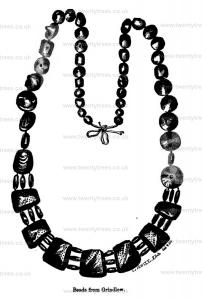

Europe, British Isles, North-Central England, Derbyshire Dales, Chatsworth Bronze Age Barrows, Calver Low Barrows [Map]
Calver Low. Having been informed, on the 30th of August, that some skeletons had been discovered the day before, by men baring the rock preparatory to quarrying it, at the verge of the cliff overlooking the limekilns at Calver Low [Map], I immediately went to the place and found that there had been five skeletons buried in a line side by side, a few feet apart, in graves sunk down to the rock which is there about two feet below the turf. The bodies were all extended at length with the heads to the west, so as not merely to admit of the corpses facing the east, as is the Christian custom of burial yet observed, but in this case also to face the village, and the pleasant valley extending towards Baslow - either motive may have prompted the arrangement, as there is reason to believe the interments to be of the Anglo-Saxon period, although it was suggested at the time, in one of the local papers, that they were remains of some who perished during the ravages of the plague at Eyam in 1666.
In returning to the narrative, it will be best to describe the several skeletons, numbering from the north, promising that the legs of all had been cut away, owing to their being so near the border of the cliff, which descends for a considerable distance almost perpendicularly, having long been quarried for lime burning.
Note 1. - A young person with very slender bones, the femur 17½ inches long, undisturbed with the exception of the skull, which had been broken and robbed of the teeth previous to our visit; a small bit of coarse red pottery was picked up amongst the earth near the bones.
Note 2.- Removed before our arrival, but from the few bones preserved, it appears that the person was older than the first, although the femur measures 16½ inches only - the skull thin, a good deal decayed and very imperfect.
Note 3. - Removed - the skull very perfect when found, since despoiled of the whole of the facial bones. The calvarium and lower jaw have been recovered. The former presents, when viewed from above, an oval outline with a very full occipital protuberance; the latter is well formed, and the state of the teeth indicates an early adult age. Imperfection in the thigh bones prevents measurement, they do not however appear to have been very long. A small iron knife, of the common Saxon shape, lay upon the pelvis of this skeleton, and has imparted a ferruginous tinge to the bone from contact during oxidyzation. It is the only instrument found with any of the interments, and alone furnishes a clue to their date.
Note 4. - With the exception of the legs, was quite undisturbed, as it lay beneath a wall on the extreme edge of the hill. By working on the other side of this fence, the skull was extracted in such a state as to be capable of restoration; it is oval, platycephalic, and like the other three - that of a young individual whose thigh bones, imperfect at each end, are large and much stronger than the appearance of the head would lead one to expect The skull is very much distorted by pressure, also producing fracture, posthumously applied to the left side of the frontal bone, most likely from stone filling the grave, as no care had in any instance been taken to protect the bodies from the overlying weight.
Note 5. - This, the most southern of the row, was entirely removed, most of the bones having been thrown down the precipice before attention was excited by a recurrence of the skeletons.
There are some indications of a tumulus in the field a few yards further back from the wall, which, if opened might disclose some- thing to substantiate the inference drawn from the presence of the iron Knife with one of the skeletons, which, however, we think is alone sufficient to determine the Saxon origin of the cemetery.
Europe, British Isles, North-Central England, Derbyshire Dales, Chelmorton Barrow 3 [Map]
Chelmorton. 23rd of June we opened a small low barrow [Probably Chelmorton Barrow 3 [Map]] in the neighbourhood of the last, which covered a rock grave three feet deep, the irregular shape of which was corrected by an interior lining of stone slabs. It was chiefly filled with stones, but had a layer of tempered earth above and below them: the latter had the nature of exceedingly tenacious clay, and in it was imbedded the skeleton of a tall man of middle age, who lay extended on his back with the head raised and pointing to the west; the hands, with the fingers extended, were placed on the thighs; an iron knife much corroded lay in an oblique direction across the left side of the pelvis, and was itself crossed by the bones of the wrist. The right femur had been fractured about 6 inches below the neck, but had firmly reunited, apparently with the effect of shortening the limb, Parallel with the right side of the body, for its whole length, was a ridge of dark-coloured earth so remarkably dense that we could not detect the substances of which it was composed in any part excepting between the right humerus and the ribs, where it contained remains of wood and of animal's skin, the earth separating with ease where the latter had been folded, and exhibiting a hairy surface almost as perfect as would be shown by a recent hide under the same circumstances of damp and pressure, colour alone excepted. Although there was a hard mass of tempered earth above the grave, a few water rats had left their bones near those of this Saxon.
Europe, British Isles, North-Central England, Derbyshire Dales, Chelmorton Thorn Barrow [Map]
Chelmorton. On the 9th of September, we opened a small grave mound [Chelmorton Thorn Barrow [Map]] near Chelmorton Thorn, Derbyshire, measuring about 9 yards across and 2 feet high. By cutting a trench through the middle we found it to consist of pudiled and tempered earth mixed with a few limestones, the latter more plentiful about the centre; beneath these, and very slightly lower than the natural surface, on a very uneven floor of rock, lay a tall but slender skeleton, evidently of a young man of the Anglo-Saxon race, who had been carefully deposited at full length on his back, with the head due west; the arms lay along the sides, but the hands had been placed upon the lower part of the person, the phalanges of the fingers being found in the hollow of the pelvis, which had become flattened by pressure from the earth above. Close to the left side of the pelvis we found two short knives and a buckle of iron, all very much corroded by the destructive action of the puddled earth, which had also decayed the skeleton so much, that it was impossible to obtain accurate measurements of any of the long bones.
It is rather remarkable, that the place has the reputation of being haunted: on the occasion of our visit a person was pointed out who had actually been favoured with a sight of the apparition, which was manifested in the form of a man of unearthly stature, who walked before the seer for some distance, about the hour of four on a summer's morning.
Europe, British Isles, North-Central England, Derbyshire Dales, Middleton-by-Youlgreave, Garratts Piece Barrow [Map]
Section I Tumuli 1788. On the 15th of March, 1788, a farmer, who occupied the land on Middleton Moor, known as the Garratt Piece, having occasion to burn some lime upon that ground, dug for the purpose into a tumulus [Map] [Garratts Piece Barrow [Map]], or lowe, there situate.
He began his work on the outer edge of the barrow, clearing it away as he proceeded, to the level of the natural surface. On reaching the centre, he found, lying immediately under the usual depression of the summit of the barrow, and placed upon the level of the ground, a skeleton, whose extremities were towards the east and west; near the point of the shoulder was a very extraordinary ornament of copper neatly enamelled with various colours, red being the most predominant; it is circular, and has a hook in the form of a serpent's head, probably for suspension. In addition to this, part of another ornament of similar workmanship; part of the iron umbo of a shield and a shallow basin of thin brass, much broken and crushed, were found abont the same place. (For a similar basin see Archæologia, vol. xviii, page 80.) The design visible upon the circular and enamelled ornament is precisely similar to an illuminated capital Q in the Saxon manuscript entitled, 'Textus Sancti Cuthberti,' a production of the seventh century, formerly preserved in the cathedral of Durham, but now in the Cottonian library, (Nero, D. 4.) There is a good engraving of it in Astle's 'Origin of Writing,' plate 14, a. This interesting barrow was reopened by Mr. William Bateman (age 1), on the 19th of June, 1826, but was found to have been entirely rifled on the occasion above described.
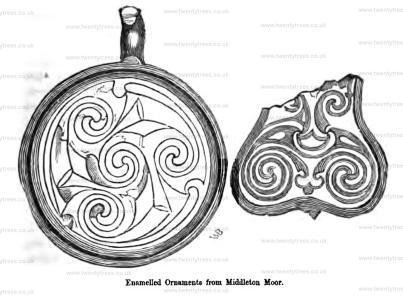
Archaeologia Volume 9 Section XVII. Discoveries in opening a Tumulus [Garratts Piece Barrow [Map]] in Derbyshire. In a Letter from the Rev. Mr. Pegge (age 83) to the Rev. John Brand, Secretary. Read May 8, 1788.
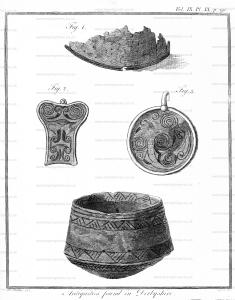
Section I Tumuli 1825. The only barrow yet discovered in a low situation in the neighbourhood of Middleton is placed in a meadow called Larks Lowe [Map], and near the rivulet called the Bradford; this tumulus was opened on the 20th of May 1825 when the cist was found to be constructed of large flat stones placed edge-ways with similar ones serving for the cover; it contained the decayed fragments of a human skeleton. On the eastern side of the barrow was found an urn of coarse earthy full of calcined bones and dry mould, the top protected by a flat piece of lime-stone, upon which was placed a small, shallow, earthen vessel very firmly baked, (of the kind denominated by Sir Richard Hoare (age 66) "incense cups"), a pin of bronze, two and a quarter inches long; several animal teeth and bones, amongst them a horse's tooth, a circular pebble, and a stone of peculiar shape; the large urn was of so friable a nature, that it probably had no other baking than what it received in the funeral fire, from this cause it was found impracticable to preserve it entire. June 19, 1826, it was thought advisable to reopen the very interesting barrow [Map] on Garratt Piece, Middleton, which was opened by Dr. Pegge in 1788, and described in the Archæologia, vol. ix, page 189; in it were found animal bones, one of which was calcined; a portion of the lower branch of an antler of the red deer, six inches in length, which had been tooled at the root by a sharp instrument; also some rats' bones. (See a subsequent examination of this barrow.)
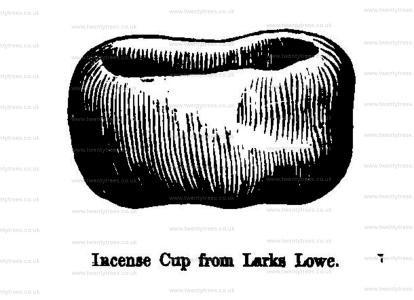
Thomas Bateman 1846. Upon reopening the remains of a barrow [Garratts Piece Barrow [Map]] upon Middleton Moor, explored by Dr. Pegge in 1788, on the 5th of October, 1847, a few small articles were recovered which indicate that the tumulus existed in times long anterior to the deposit of the very remarkable Saxon antiquities therein discovered and described in the earlier part of this section and which farther tend to strengthen the idea that in this part of the country there exist no barrows purely of Saxon origin. The articles with, the exception only of some fragments of light-coloured kiln-baked pottery, are of Celtic manufacture and usage, consisting of pieces of stags' horns, instruments of flint, amongst which was one of elongated shape very neatly chipped; and, lastly, remains of bone instruments, one of the latter presenting a very neat example of the lance-head of that material, being nicely worked into form out of the leg-bone of some small animal. Similar points are seen to some of the arrows brought from New Zealand.
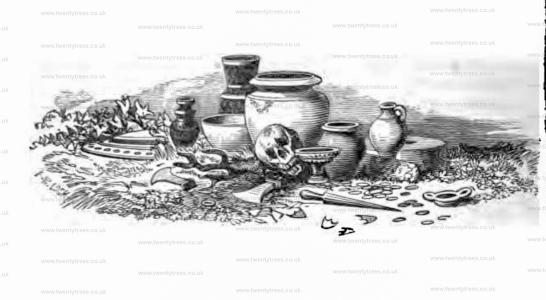
Europe, British Isles, North-Central England, Derbyshire, High Peak, Buxton, Hasling Houses Barrow [Map]
Hasling Houses. On the 3rd of June, we opened a barrow at Hasling Houses [Map], near Buxton, measuring about twelve yards across and three feet in height, chiefly composed of tempered earth, except in the centre, where were a good many stones, covering a grave cut from east to west, about eighteen inches deep. Within it lay at length the skeleton of a powerful man of middle age, with the head to the west, who had been buried either within a coffin, or upon a thick plank with another above him, in order to keep off the pressure of the stones. In the earth, about a foot from the skull, we, found a rude instrument of flint, probably unconnected with the interment, and brought with earth from the neighbouring field as material for the mound. The femur measures 19½ inches; and both bones of the left leg had been fractured just below the knee, and strongly re-united by the formation of osseous substance many years before death. The body was most probably that of a Saxon.
Europe, British Isles, North-Central England, Derbyshire Dales, Bakewell, Hay Top Barrow [Map]
Hay Top Barrow is also in Peak District Bronze Age Barrows, .
Monsal Dale. On the same afternoon, we began an examination of a large mutilated flat-topped barrow [Hay Top Barrow [Map]], twenty yards diameter and four feet high, on the summit of a hill called Hay Top, overlooking the manufacturing colony of Cressbrook. The mound is piled upon a naturally elevated rock, so as not to present more than two feet of accumulated material in the middle, where we began to dig, finding remains of many individuals, from infants to adults of large stature (an imperfect femur, broken off below the neck, measuring near nineteen inches), but all were in disorder except one skeleton, which appeared to lie on its left side in the centre; it was, however, so much surrounded by other bones as to be rather difficult to identify, and, from the same confusion, we cannot positively assign all the following articles to it, though there is scarcely a doubt that the flints and bone ornament were buried with it: - The objects referred to, are ten jet beads of the three common shapes, several flints, including three thick arrow points, and a curious bone ornament, with a hole for suspension round the neck, where it was found, not unlike a seal with a rectangular face. The skeleton, from the slenderness of the bones, was judged to be that of a female. We casually found pieces of two vessels, a polecat's skull, and many bones of the water-vole.
Monsal Dale. On the 23rd of May, we resumed our labour in two parties, digging at once on either side, between our former cutting and the north and south verge of the mound [Hay Top Barrow [Map]], and carrying on the trenches towards the west, where the barrow was most perfect, the whole of the eastern edge having been carted away. In the south cutting we found an oval cist about three feet from the surface, sunk a foot in rock and lined with a few flat stones; the diameter was under a yard, but it contained the skeleton of an aged man lying on his right side, with the knees necessarily so much drawn up as to approach the face, the head pointed to the south-west: and near it was a neat ornamented vase of imperfectly baked clay, 5½ inches high, and a perforated bone pin, about six inches long. On this side the tumulus was also found part of another skull, which had been removed from some other place.
While these discoveries were being made, the excavation on the north side was equally productive, for immediately below the grass were many fragmentary human bones, amongst which we found an iron spear, with the socket broken, yet 9½ inches long; and a blue glass bead, with a spiral thread of white running through it, which objects, we were informed, had been disturbed many years before, by a man digging in the mound under the impression of its being a mineral hillock: they must have belonged to a body interred near the surface at a late or Saxon age. Proceeding deeper, we found the rock cut away for a large space about two feet lower than its ordinary level, making the entire depth from the grass rather more than four feet. At the east extremity of this excavation there was a small enclosure of flat stones, something like that on the other side, before described, containing a skeleton much contracted, and in this case lying on its lefl side, with the head to the south, accompanied by one flint arrow point.
About the middle of the excavation, in the rock, were two rather small human crania, placed side by side, near a drinking-cup 7¼ inches high, ornamented with a lozengy pattern. Upon the crown of one of the skulls was a neatly chipped instrument of grey flint, and it is singular that no trace either of the lower jaws or of any other parts of the skeletons could be seen, though no dis-arrangement had ever taken place in this part of the mound, and it is certain that the crania alone had been buried there. At a little distance from them were the skeleton of a child, and one cylindrical jet bead. These discoveries, with the occurrence of numerous broken bones, both human and animal in the upper parts of the trenches, terminated the labours of the day. A portion of the west side of the mound intervening between the cuttings being reserved for the next day's examination, when it was cut out to the level of the rock, disclosing a grave about a yard square, sunk about three feet lower. Inside this excavation was a very neat rectangular cist, 2 feet long and 18 inches wide, formed of four flat slabs of limestone, filled with limestone, gravel, and rats' bones, which being very carefully removed, allowed us to see the skeleton of a child, doubled up, with the head to the south, and a most beautiful little vase, 4⅜ inches high, completely covered with a minute chevron pattern, lying obliquely in contact with the pelvis of the child, which had become thrust into it by the pressure of the grave; the depth at which this deposit lay was about five feet from the surface of the mound. The skeleton of the child is arranged in a glass case at Lomberdale House [Map], and from the abnormal shape of the head, it is probable that death was occasioned by hydrocephalus. Many burnt bones, and disjointed bones, as before, were found in the course of the day. The plan of this interesting barrow will illustrate the foregoing account.

Europe, British Isles, North-Central England, Derbyshire Dales, Cressbrook, High Field Hlaew [Map]
Brushfield. On the 3rd of August, we opened a finely shaped barrow [High Field Hlaew [Map]] near Brushfield, upon Lapwing HiU, overlooking Cressbrook valley, measuring seventeen yards across and four feet high in the centre, composed of earth, with a few stones in the middle, where a shallow grave, about a foot deep, was sunk in the rock. In it lay extended the remains of a human body, so very much decayed as to be almost undistinguishable, but which we ascertained to have been deposited with the head to the west. Beneath the remnants of bone were many traces of light-coloured hair, as if from a hide, resting upon a considerable quantity of decayed wood, indicating a plank of some thickness, or the bottom of a coffin. At the left of the body was a long and broad iron sword, enclosed in a sheath made of thin wood covered with ornamented leather.
Under the hilt of the sword, which like most of ancient date is very small, was a short iron knife; and a little way above the right shoulder were two small javelin heads, 4½ inches long, of the same metal, which had lain so near each other as to become united by corrosion. Among the stones which filled the grave, and about a foot from the bottom, were many objects of corroded iron, including nine loops of hoop iron about an inch broad, which had been fixed to thick wood by long nails; eight staples or eyes, which had been driven through plank and clenched; and one or two other objects of more uncertain application, all which were dispersed at intervals round the corpse throughout the length of the grave, and which may therefore have been attached to a bier or coffin in which the deceased was conveyed to the grave, possibly from some distant place. The only specimen of a Saxon sword, which was the weapon of the thegn, previously found in this part of Derbyshire, was singularly enough found with the umbo of a shield on the same farm in 1828; thus indicating the connection of a noble Saxon family with Brushfield in the age of Heathendom, the name of which is perpetuated in a document of the 16th century, preserved in the British Museum1.
Note 1. Mortgage of Lands in Little Longsdon, Monsall Dale, and Brighterighefield (Brightric's Field,) otherwise Brushefielde, between Thomas Shakerley of Derby and Rowland Eyre of Hassoppe; dated May. 37th Elizabeth. B. Mus: Additional MSS. 6702. fol 45.
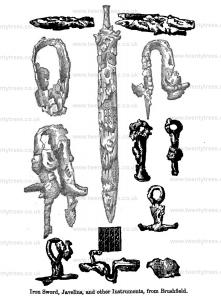
Frederick Lukis 1865. Notice Of The Opening Of A Barrow [Map] On Grey Cap Hill, Cressbrook, October 15, 1867 By B. J. F. Lucas, Esq.
Europe, British Isles, North-Central England, Staffordshire, Waterhouses, Musden Hill, Musden Second Barrow [Map]
Musden Second Barrow. July 18th, investigated a second barrow [Map] on Musden Hill, about a hundred yards from that opened on the 10th inst.; we cut two transverse sections through the centre, where a few burnt hones were found. More to the east was a skeleton with the head to the outside of the barrow, near it was a lump of flint devoid of form; and above and around it were fragments of two globular narrow-necked urns, ornamented with a few projections upon the shouliers, which had contained burnt bones. These are of the kind attributed to some of the Saxon tribes, many examples having been found in various cemeteries in this country, as well as on the Elbe, by the late Mr. Kemble. Below the calcined bones that had filled these urns was a thin layer of gravel, which had been exposed to heat sufficient to melt the small particles of lead ore usually found in it. Many pieces of flint were picked up in this part of the barrow, and part of a medieval pitcher, with vertical streaks of green glaze, was observed. None of the intererments had been protected by cists.
Europe, British Isles, North-Central England, Staffordshire, Waterhouses, Musden Hill, Musden Third Barrow [Map]
Musden Third Barrow is also in Peak District Bronze Age Barrows.
Musden Third Barrow. On the 19th of May, we opened the third [Musden Third Barrow [Map]] of the group of barrows upon Musden Hill, which is a fine regularly shaped mound eighteen yards diameter, and five feet high, composed of nothing but stiff clayey earth. The natural soil was touched at the depth of four feet, and was changed to a red colour by fire, the traces of which, in the form of charcoal, strewed the surface for a considerable length. A round hole had been sunk about a foot through the upper stratuna of rock, near the centre of the barrow, which was filled with small stones and clay; a few burnt bones and some pieces of burnt flint, one of them part of a large instrument, were found about this part of the mound, but no interment was discovered although extensive trenches were made. There is little doubt of an interment by cremation being yet in some part of the barrow, which is one of the same class as those near Longnor, opened in 1848.
Lady Low. 20th of April, we reopened the third barrow [Musden Third Barrow [Map]] on Musdin Hill, examined on the 19th of May, 1849, by making a wide section through the middle. This time we cut a circular trench around our former excavation, and found some burnt bones near the surface, with a small piece of an urn and two flints. The upper part of the barrow was composed of diflerently coloured earth from the lower, in which we found no interment, although it showed no traces of having been disturbed by former digging.
Europe, British Isles, North-Central England, Staffordshire, Swinscoe, Near Hill Barrow [Map]
Swinscoe aka Near Hill Barrow. On the 7th of July, we opened a barrow [Near Hill Barrow [Map]] on the Near Hill, Swinscoe, thirteen yards diameter, with a basin-like depression in the middle, five yards over and three feet deep. Having sunk to the depth of five feet from the basin, through earth and stone, a skeleton was found, the lower part of which only was undisturbed, the head and upper portion having apparently been long removed. Their fragments, with small pieces of burnt bone, Samian ware, and a piece of iron of no great antiquity, were found throughout the cutting from the surface downwards. The femur of the skeleton, wanting the joint at the knee, measures 18½ inches, and must have been near two inches longer.
Europe, British Isles, North-Central England, Staffordshire, Waterhouses, Over Low Barrow [Map]
Over Low Barrow [Map], located 420m south of Nibs End Farm on a low-lying shelf in a valley situated a short distance north-north-west of the head of the steep valley containing Tinsell Brook. It survives as an oval mound of sand, small stones and earth up to 1.8m high with maximum dimensions of 35m by 33m. Limited antiquarian investigation close to the centre of the mound located two contracted inhumations, one of which was surrounded by a partial cist formed of a few flat stones. Flints and an urn sherd were also found.
Stanton. 28th of December, we opened a barrow called Over Low [Map], placed on the side of a hill, on the summit of which are some earthworks, near the village of Stanton. The tumulus, about 28 yards diameter, is composed of small sandstones and sand; near the middle were two contracted skeletons, very much decayed, lying within a yard of each other: a few flat stones placed on edge, so as to form a sort of cist, were placed round one of them, which was also accompanied by a few mean implements of flint, and one piece of thick coarse pottery.
Europe, British Isles, North-Central England, Staffordshire, Waterhouses, Pike Low Barrow [Map]
Europe, British Isles, North-Central England, Staffordshire, Waterhouses, Ribden Low Barrow [Map]
Ribden Low. 29th of December, a barrow [Ribden Low Barrow [Map]] was opened between the villages of Cotton and Cauldon, called Ribden Low, about 30 yards diameter. In cutting through the centre, we found a large flat stone covering a rudely walled cist, built upon the natural surface, about three feet from the top of the barrow, containing a much decayed skeleton, which reposed in the usual flexed position, on its left side, accompanied by a remarkably beautiful spear-head of flint, and some other pieces of the same material, all of which had been slightly burnt; at the feet was a human skull much decayed. The ground continuing to sink by the side of the cist, we were led to another interment, which consisted of a deposit of calcined bones, placed in a hole dug two feet lower in the natural soil, and paved with flat stones. Amongst the bones were found three large instruments, and three barbed arrow-heads of flint, remains of about five bone implements, some of which appear to have been modelling or netting tools; others pointed at each end are perforated through the middle. They are all in bad preservation, owing to their having been calcined along with the corpse of the owner. The barrow was thickly strewn with burnt bones, fragments of pottery, and rats' bones.; and two very small pieces of bronze, slightly ornamented, were found near the capstone of the cist.
Europe, British Isles, North-Central England, Derbyshire Dales, Hartington, Alsop-en-le-Dale, Stand Low Barrow [Map]
Thomas Bateman 1845. On the 19th of June, 1845, a very interesting barrow, called Stand Lowe [Map], was opened, which is situated upon an elevation, opposite to Moot Lowe [Map], on the other side of the Dovedale road. On digging towards the centre of the barrow, numerous chippings of flint were found, amongst which were six rude instruments, mostly calcined, one of which had been used as a saw, and is very curious; about the same place was found a broken whetstone. The centre being gained, an iron knife was found, of the kind attributed to the Saxons by the modem school of antiquaries, which was immediately followed by a bronze box, of a circular form and much decayed, ornamented by rows of little indented dots, and having a moveable handle, wrought into the form of a serpent's head, the eye being perforated through for convenience of suspension the hinge of the lid is very perfect, and of workmanship which would not disgrace a Birmingham artisan of the present day; near this box lay a small knife which appears to have been protected by an iron sheath, two bronze rings, which had evidently been used as buckles or fibulae, and some other articles of iron, which bear evident marks of having been folded in linen, and are now so shapeless from the effects of rust, that it is difficult to assign a use for them. About the same place was found a small piece of a ribbed vessel of thin yellow glass. There being no indications of bone, or change of colour in the soil, the scrupulous care, so necessary on these occasions, was not used; consequently, the hack was struck amongst a quantity of glass-beads, fortunately, one only was broken; on examination were found eleven glass beads of various shapes and sizes, three of which are remarkably variegated; a bead made of silver wire twisted in a spiral form, and diminishing in the size of the whorls each way from the centre; and a silver needle, with a curiously-formed eye. Amongst the beads were picked up the remains of twenty-six human teeth, consisting merely of the enamel or crown of the tooth; which, owing to some cause perhaps the nature of the soil were the only vestiges of the primeval beauty over whose mouldering remains this barrow had been raised by the hand of affection. At the time of interment the beads were doubtless placed round the neck and from the position of the box, knives, and rings, it is equally evident that they lay on the left side of the body. In Douglas's "Nenia Britannica," plate 18, page 72, a somewhat similar box, containing thread, and a similar needle are figured, which were found in a barrow at Sibertswold, in Kent, opened by Dr. Faussett, about the year 1767. The fact of finding instruments of flint with an interment of this comparatively modem description is rather remarkable, but not by any means unprecedented.
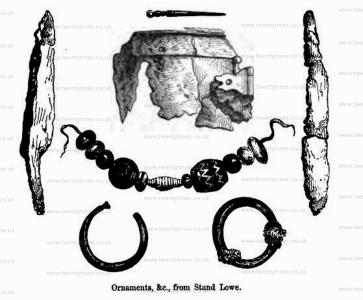
Europe, British Isles, North-Central England, Derbyshire Dales, Hartington, Vincent Knoll Barrow [Map]
Vincent Knoll. May 24th. - We explored the remnant of a large barrow in a field near Parcelly Hay, called Vincent Knoll [Map]. The portion remaining had been the central part of the mound, and had been recently disturbed down to the natural surface of the field, fortunately without injury to the interments, which lay about two feet deeper in an irregularly shaped grave cut in the rock for their reception. To make the description intelligible we will call the grave an elongated oval though it was not strictly so, the rock having been removed in accordance with the natural angular and irregular joints. At one side of the grave was a skeleton, lying on its left side with the legs gathered up, accompanied only by the core of a cow's horn which lay upon the ribs. This skeleton, which was that of a male, exhibited a singular malformation of the upper part of each femur; close to its feet, and near one eixd of the oval, was a second skeleton of slender make which had been buried in a slovenly manner, it had with it a very large tooth of some animal, which, as well as both skeletons, was much decayed: they were surrounded by rats' bones, and a few inches above them was a thin layer of black earth, running through the small stones that filled this part of the grave. On the opposite side lay a third skeleton which faced the first, and was deposited in the same portion on its left side, the head being, of necessity, in the contrary direction: near the pelvis was a very neat circular ended instrument of white flint, and about a foot from the legs was a small iron spear with an open socket much corroded, which, however, did not appear to belong to the interment. This body in better condition than the others, was not surrounded by so many rats' bones, and was covered by larger stones. Following the side of the grave to the end of the oval, opposite to that occupied by the second skeleton, was found, about two feet from the last, the upper part of a fourth, to which, it is probable, the iron spear belonged: the bones were in good condition, but lay huddled together as if the body had been hastily buried. Careful observation at the time led to the conclusion that the two first bodies were interred at the same time, that the third deposit took place at a subsequent, but very early period, and that the fourth was of comparatively modem introduction, not dating earlier than the Pagan-Saxon age.
Europe, British Isles, North-Central England, Staffordshire, Waterhouses, Wredon Hill Barrow [Map]
Readon Hill. September 4th, opened a barrow nineteen yards diameter and three feet high, on Readon Hill [Possibly Wredon Hill Barrow [Map]], near Ramshorn, which is mentioned by Plot, Hist. Staff, fol. 1686, p. 404. It contained two skeletons extended at length, about the centre, without any protection from the earth of which the mound was formed, with the exception of a few stones in contact with one of the bodies, which was possibly interred at a subsequent period to the other, as it was not more than two feet from the surface of the barrow, whilst the other lay on the natural level, at least three feet from the turf covering the mound. Vestiges of the hair of the former were perceptible about the skull, which was that of a young man, and in perfect preservation; and a small pebble was found at the right hand (compare Barrow [Map] opened 30th May, 1845, Vestiges, p. 67). The other, and probably earlier interment, was covered with a thin layer of charcoal. The skull is that of a middle-aged man, the vertex much elevated, the left side completely decayed from lying in contact with the floor of the barrow. At some distance from either of the skeletons, but nearest to the higher interment, from which, however, they were full two yards, lay an iron spear, thirteen inches long, with part of the shaft remaining in the socket, and a narrow iron knife, eight inches in length. An examination of these by the microscope, enables us to add the further information that the spear has been mounted on an ashen shaft, about one inch of which yet remains, owing its preservation to being saturated by the ferruginous matter produced by the decomposition of the iron - outside the iron are numerous casts of grassy fibre, and the larvae of insects, apparently flies - the grass must have been present at the time of interment in considerable quantity. The knife shews fewer traces of the vegetable, and more of the animal structures, the tang where inserted into the handle, shews the impression of horn. It is fortunate that metals in a state of oxydization have the property of taking, and retaining, the most delicate casts of substances the most perishable with which they lie in contact; we thus gain much valuable information as to the materials of dress in times of pre-historic antiquity, and are enabled to describe the circumstances under which the dead were committed to the grave, with an exactitude resulting from a strictly inductive method of reasoning. For example, we find that the early Celtic population, whose chief men were armed with the bronze celt and dagger, not only wore the skins of animals during life, but were enveloped in the same after death, and were thus laid upon a bed of moss or fern, before being buried out of the sight of their friends beneath the sepulchral mound. In later times, when the use of iron became so general as to supersede the more ancient metal bronze, we find a corresponding advancement in the materials of clothing, the impression of woven fabrics, of varying degrees of fineness, being almost invariably distinguishable on the rust of weapons found in the barrows; although the old custom of providing a grassy couch for the remains of the deceased was still retained, from an intuitive feeling beautifully expressed by Sir Thomas Browne, in his Hydriotaphia, when referring to the sepulture of the ancients, he writes - "that they have wished their bones might lie soft, and the earth be light upon them. Even such as hope to rise again would not be content with central interment, or so desperately to place their reliques as to be beyond discovery, and in no way to be seen again; which happy contrivance hath made communication with our forefathers, and left unto our view some parts which they never beheld themselves."
On the following day we examined another barrow in the same neighbourhood, about 21 yards diameter. It is called Wardlow, and is constructed over a lump of rock, in the middle of which was cut a grave, which we found had been previously disturbed, it had originally contained a skeleton with burnt bones, and chippings of flint. A cutting through the side of the mound where there was the greatest accumulation of factitious earth, produced many fragments of human bone, together with those of the water rat.